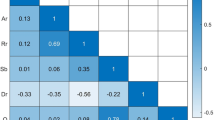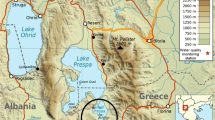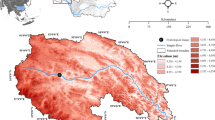Abstract
As a UNESCO biosphere, Lake Urmia is a shallow hypersaline lake which is facing a rapid water surface degradation. Evaporation from the surface of the Lake, as a physical process which accelerates the Lake’s degradation, was evaluated using chaos theory. Seven hydrometeorological stations scattered around the Lake were selected, and a 40-year time span between October 1974 and September 2014 was used at each station. Missing data in time series was removed and the whole time series was tested for consistency, randomness, and presence of trend. Since evaporation at each station was measured by means of class A evaporation pan, time series at each station was multiplied by a pan coefficient to incorporate the effect of saline water and free water surface environment simultaneously. Measurement errors arising from assumption of zero evaporation in winter were removed from the time series using locally weighted scatterplot smoothing method after which unification of time series into a single time series is achieved. Results of the data transformation and information loss were monitored by means of auto-correlation, partial-auto-correlation, mutual information, power spectrum, false nearest neighbor, and correlation dimension. A local prediction method is then used to capture the temporal dynamics of the evaporation with consideration of an appropriate time delay and embedding dimension. Finally, the representative model was projected on a 3-dimensional phase space to evaluate the temporal dynamics of the evaporation. Results indicate that the chaotic approach shows accurate predictions in advance.








Similar content being viewed by others
References
Addison PS (1997) Fractals and chaos: an illustrated course. Institute of Physics Publishing, Dirac House, Bristol
Adeloye AJ, Montaseri M (2002) Preliminary streamflow data analyses prior to water resources planning study. Hydrol Sci J 47(5):679–692
Baydaroglu O, Kocak K (2014) SVR-based prediction of evaporation combined with chaotic approach. J Hydrol 508:356–363
Bras RL (1990) Hydrology: an introduction to hydrologic science. Addison-Wesley Publishing Co, New York
Brutsaert W (2013) Evaporation into the atmosphere: theory, history and applications, vol 1. Springer Science and Business Media, Amsterdam
Cleveland WS (1979) Robust locally weighted regression and smoothing scatterplots. J Am Stat Assoc 74(368):829–836
Cleveland WS, Devlin SJ (1988) Locally weighted regression: an approach to regression analysis by local fitting. J Am Stat Assoc 83(403):596–610
Cleveland RB, Cleveland WS, McRae JE, Terpenning I (1990) STL: a seasonal-trend decomposition procedure based on LOESS. J Off Stat 6(1):3–73
Dehghan S, Kamaneh SAA, Eslamian S, Gandomkar A, Marani-Barzani M, Amoushahi-Khouzani M, Singh VP, Ostad-Ali-Askari K (2017) Changes in temperature and precipitation with the analysis of geomorphic basin chaos in Shiraz, Iran. Int J Constr Res Civ Eng 3(2):50–57
Eslami A, Ghahraman B, Ziaee A, Eslami P (2016) Effect of noise reduction in nonlinear dynamic analysis of maximum daily temperature series in Kerman Station. Iran-Water Resour. Res 12(1):171–185 (In Farsi)
Farzin S, Ifaei P, Farzin N, Hassanzadeh Y, Aalami MT (2012) An investigation on changes and prediction of Urmia Lake water surface evaporation by chaos theory. Int J Environ Res 6(3):815–824
Farzin S, Hajiabadi R, Ahmadi MH (2017) Application of Chaos theory and artificial neural networks to evaluate evaporation from lake’s water surface. J Water and Soi 31(1):61–74
Fuwape IA, Ogunjo ST, Oluyamo SS, Rabiu AB (2017) Spatial variation of deterministic chaos in mean daily temperature and rainfall over Nigeria. Theor Appl Climatol 130(1–2):119–132
Gao ZK, Yang YX, Fang PC, Jin ND, Xia CY, Hu LD (2015) Multi-frequency complex network from time series for uncovering oil-water flow structure. Sci Rep 5:8222
Ghorbani MA, Khatibi R, Mehr AD, Asadi H (2018) Chaos-based multigene genetic programming: a new hybrid strategy for river flow forecasting. J Hydrol 562:455–467
Hashemi M (2008) An independent review: the status of water resources in the Lake Uromiyeh Basin. UNDP/GEF “Conservation of Iranian Wetlands” Project: 37–38
Hassanzadeh E, Zarghami M, Hassanzadeh Y (2012) Determining the main factors in declining the Urmia Lake level by using system dynamics modeling. Water Resour Manag 26(1):129–145
Hegger R, Kantz H, Schreiber T (2018) The TISEAN downloads and updates page. Max Planck Institute for the Physics of Complex Systems (MPIPKS). Dresden, Germany. https://www.pks.mpg.de/~tisean/archive_3.0.0.html. Accessed 26 Jan 2018
Huisman J, Thi NNP, Karl DM, Sommeijer B (2006) Reduced mixing generates oscillations and chaos in the oceanic deep chlorophyll maximum. Nature 439(7074):322–325
Iranian Department of Environment (2009) Integrated management plan for Lake Urmia Basin: protecting lagoons for people, for environment. Under supervision of UNDP/GEF. 22 May 2009 Urmia, Iran
Iranian Water Resource Management Company (2015) Daily rainfall report of Iran based on seconder catchment areas. http://wrs.wrm.ir/m3/gozaresh.asp. Accessed 15 Jun 2015
Itoh KI (1995) A method for predicting chaotic time-series with outliers. Electronics and Communications in Japan (Part III: Fundamental Electronic Science) 78(5):44–53
Jensen ME (2010) Estimating evaporation from water surfaces. In CSU/ARS Evapotranspiration Workshop, Fort Collins, CO, pp 1–27
Kamran KV, Khosroshahi SS, Omrani K (2014) Examining the decreasing Urmia Lake water depth and effects that on the environment. Proceedings of International Conference on Agriculture, Environment and Biological Sciences (ICFAE 2014). 4–5 June 2014 Antalya, Turkey, pp 26–29
Kennel MB, Brown R, Abarbanel HD (1992) Determining embedding dimension for phase-space reconstruction using a geometrical construction. Phys Rev A 45(6):3403–3411
Khatibi R, Sivakumar B, Ghorbani MA, Kisi O, Kocak K, Zadeh DF (2012) Investigating chaos in river stage and discharge time series. J Hydrol 414:108–117
Kocak K, Saylan L, Sen O (2000) Nonlinear time series prediction of O3 concentration in Istanbul. Atmos Environ 34(8):1267–1271
Kocak K, Bali A, Bektasoglu B (2007) Prediction of monthly flows by using chaotic approach. In International congress on river basin management. 22–24 March 2007, Antalya, Turkey
Kohler MA, Nordenson TJ, Fox WE (1955) Evaporation from pans and lakes. US Dept Com Weather Bur Res Paper 38, Washington, D.C.
Kokya BA, Kokya TA (2008) Proposing a formula for evaporation measurement from salt water resources. Hydrol Process 22(12):2005–2012
Luke A (2018) Heat transfer in evaporation on micro- and macrostructured tubes. In: Innovative heat exchangers. Springer, pp 135–166, Cham
McGhee JW (1985) Introductory statistics. West Group, New York
Millan H, Kalauzi A, Cukic M, Biondi R (2010) Nonlinear dynamics of meteorological variables: multifractality and chaotic invariants in daily records from Pastaza, Ecuador. Theor Appl Climatol 102(1–2):75–85
Ozgur E, Kocak K (2015) The effects of the atmospheric pressure on evaporation. Acta Geobalcanica 1(1):17–24
Pahnehkolaei SMA, Alfi A, Sadollah A, Kim JH (2017) Gradient-based water cycle algorithm with evaporation rate applied to chaos suppression. Appl Soft Comput 53:420–440
Penman HL (1948) Natural evaporation from open water, bare soil and grass. In Proc. R. Soc. Lond. A, vol 193, No. 1032, pp 120–145). The Royal Society, UK
Rubel F, Kottek M (2010) Observed and projected climate shifts 1901–2100 depicted by world maps of the Köppen-Geiger climate classification. Meteorol Z 19(2):135–141
Sanchez L, Infante S, Marcano J, Griffin V (2015) Polynomial chaos based on the parallelized ensemble Kalman filter to estimate precipitation states. Stat Opt Inf Comp 3(1):79–95
Santiago Duarte Prieto F, Hernandez Murcia OE, Corzo Perez GA, Santos Granados GR (2017) Chaos analysis of precipitation time series in the upper Magdalena River Basin. In: EGU general assembly conference abstracts, vol 19, p 18496
Sima S, Ahmadalipour A, Tajrishy M (2013) Mapping surface temperature in a hyper-saline lake and investigating the effect of temperature distribution on the lake evaporation. Remote Sens Environ 136:374–385
Solomatine DP, Velickov S, Wust JC (2001) Predicting water levels and currents in the North Sea using chaos theory and neural networks. In Proceedings of the 29th Congress-International Association for Hydraulic Research. 16–21 September 2001, Beijing, China, pp 353–359
Stosic T, Stosic B, Singh VP (2018) q-triplet for Brazos River discharge: the edge of chaos. Physica A 495:137–142
Vaheddoost B, Aksoy H (2017) Structural characteristics of annual precipitation in Lake Urmia Basin. Theor Appl Climatol 128(3):919–932
Vaheddoost B, Aksoy H. (2018, Online First) Interaction of groundwater with Lake Urmia in Iran. Hydrol Process DOI: https://doi.org/10.1002/hyp.13263
Wang L, He WP, Liao LJ, Wan SQ, He T (2015) A new method for parameter estimation in nonlinear dynamical equations. Theor Appl Climatol 119(1–2):193–202
World Maps of Köppen-Geiger Climate Classification (2015) World maps and computer animations of our updated Köppen-Geiger climate classification, accessed. http://koeppen-geiger.vu-wien.ac.at/present.htm. Accessed 26 Jul 2015
World Meteorological Organization (1988) Analysing long time series of hydrological data with respect to climate variability. WCAP-3, WMO/TD no. 224. World Metrological Organization, Geneva
Wu J, Lu J, Wang J (2009) Application of chaos and fractal models to water quality time series prediction. Environ Model Softw 24(5):632–636
Wu YP, Zhu CY, Feng GL, Li BL (2018) Mathematical modeling of Fog-Haze evolution. Chaos, Solitons Fractals 107:1–4
Yekom Consulting Engineers (2002) Management plan for the Lake Uromiyeh ecosystem. 1st Report- EC-IIP, environmental management project for Lake Uromiyeh. Tehran, Iran
Acknowledgments
The authors are thankful for Iranian Water Resource Management Company for providing evaporation data of Lake Urmia. We also appreciate the valuable comments declared by editor and reviewers which were helpful in developing the quality of the study.
Author information
Authors and Affiliations
Corresponding author
Additional information
Publisher’s note
Springer Nature remains neutral with regard to jurisdictional claims in published maps and institutional affiliations.
Rights and permissions
About this article
Cite this article
Vaheddoost, B., Kocak, K. Temporal dynamics of monthly evaporation in Lake Urmia. Theor Appl Climatol 137, 2451–2462 (2019). https://doi.org/10.1007/s00704-018-2747-3
Received:
Accepted:
Published:
Issue Date:
DOI: https://doi.org/10.1007/s00704-018-2747-3




